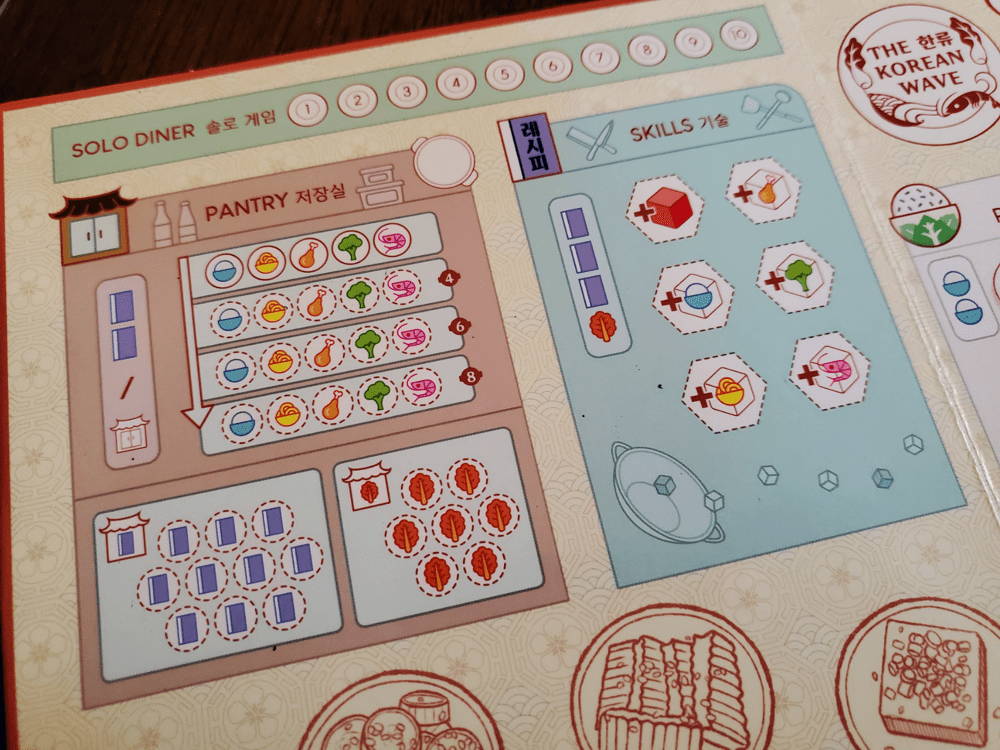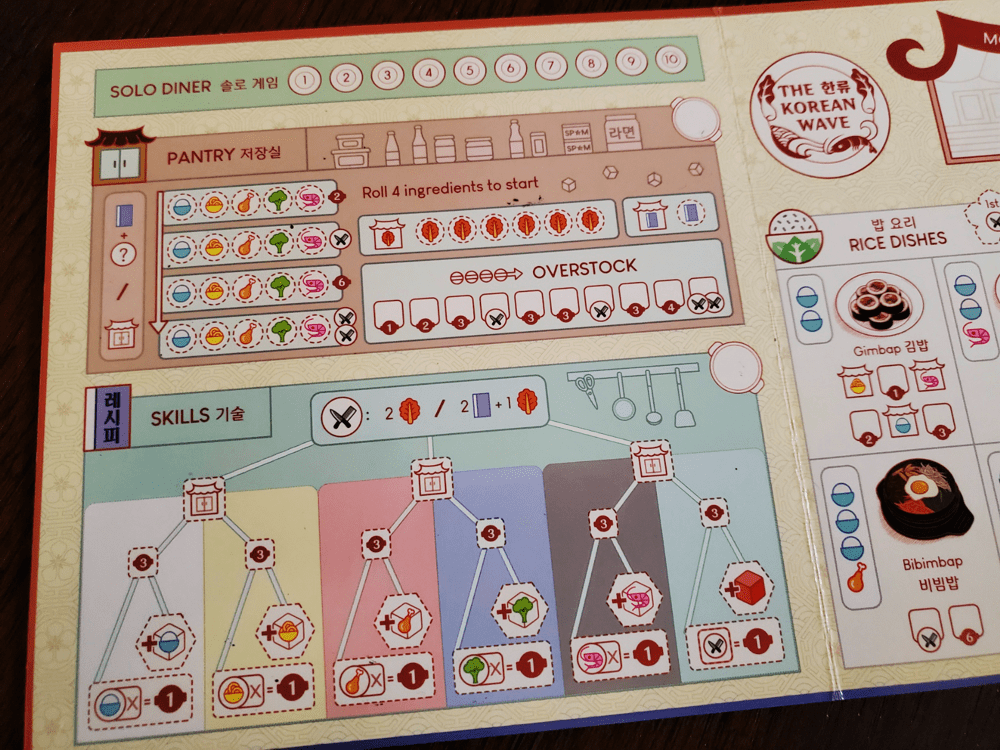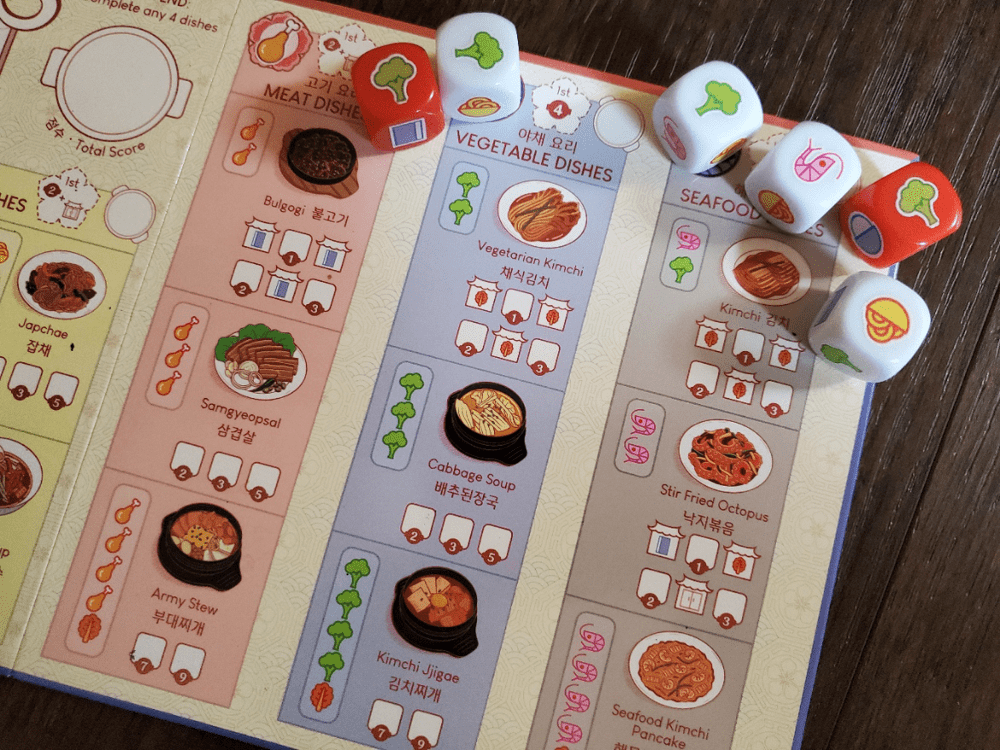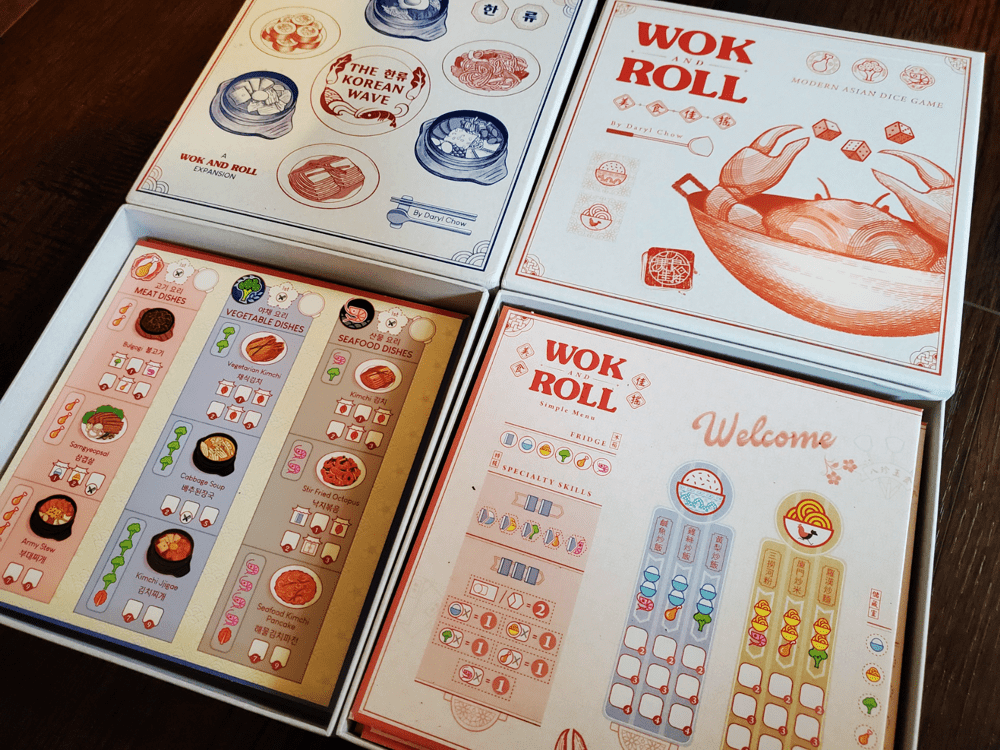Disclosure: Meeple Mountain received a free copy of this product in exchange for an honest, unbiased review. This review is not intended to be an endorsement.
I suppose one might call it fitting that the first sight to greet you upon opening the box of Wok and Roll is the scripted text reading “Welcome.” Colloquial. Charming. Quaint. The entire base game there summarized in a single word.
The most complicated dish pictured requires but a few simple ingredients. The marked point values are low and unintimidating. Upon closer examination, the first menu is labeled “Simple.” Nothing could be more inviting than such a first impression.
Eventually the base game turns to the “Expert” side with more icons and options, more strategy and possibility. Still, that scripted “Welcome” and the stress-reducing margins around the edge of the board act as a constant reminder that this is lighter fare for a relaxing evening of dice and dry-erase markers.
Somewhere along the way, someone started asking, What if there was more? What if we had 100% more food images, 50% more game board, a 33% longer experience, 20% more ingredients, 20% less margin space, and Spam? Wait, Spam? Well, we’ll just keep it on the shelf. In the game, we’ll go with Kimchi. Of course, we’ll have to drop the “Welcome” bit. How’s that sound? So be it.
 Now we’ve entered the territory of Wok and Roll: The Korean Wave, the first expansion pack for Daryl Chow’s culinary roll-and-write from the team at Origame. The box comes with new double-sided, tri-fold menus for five players and nothing more. From start to finish, The Korean Wave feels like the original, but with a bit more Gochujang.
Now we’ve entered the territory of Wok and Roll: The Korean Wave, the first expansion pack for Daryl Chow’s culinary roll-and-write from the team at Origame. The box comes with new double-sided, tri-fold menus for five players and nothing more. From start to finish, The Korean Wave feels like the original, but with a bit more Gochujang.
Key Additions
The restaurant’s new Ingredient is Kimchi. With only the base game dice and Ingredients in operation, The Korean Wave utilizes the game board to provide this fermented veggie as a bonus for completing certain dishes. Kimchi then participates in the most lucrative dishes and the most potent Skills.
Speaking of Skills, the Red Die, when unlocked, allows a player to employ one of the red dice, typically reserved for the active player, during each opponent’s turn. Access to a fifth die equals greater flexibility and maximum potential, especially if you can grab this Skill early.

The Pantry has also taken on a more dynamic presence, granting greater bonuses throughout the game by collecting ingredients in depth and breadth. Each set of ingredients now unlocks a bonus of sorts while also providing resources.
While we’re talking about additions, the graphics are more, well, just more in The Korean Wave. Where the base game is strictly iconography, the expansion includes an image of each dish. Though the boards are a bit more busy for it, the overall appearance exudes more of a restaurant vibe than before.
The Traditional Menu
There have been no changes to the core ruleset from Wok and Roll. Six dice. Yahtzee-style rolling. The active player uses all six dice, while the other players use four. Make dishes. Collect bonuses. Score points.
The Traditional menu reveals a change in scale from the outset, though, as several dishes are worth nearly double what they were in the base. The bottom row, containing the most lucrative scoring opportunities, is where you look for dishes containing Kimchi and four of something. These dishes aren’t easy, but there are several adjustments to the Pantry and the Skills to help along the way.

Building on the original Pantry, two Recipe books can now be spent to add any Ingredient to the Pantry. Rather than dispersing random Ingredients around the board, the Traditional side seeks a bit more intentionality. Only Recipe books and Kimchi come by way of completing dishes. For three books, players can purchase Skills—those bonus Ingredients that bolster the usual production.
First Dish bonuses spice up the process, granting a boon to the first player to complete every occurrence of a Dish in one of the game’s five genres: Rice, Noodle, Meat, Veggie, Seafood.
The bonus consists of points and possibly a free Pantry item.
The game ends when one player completes their fourth Dish set—a step up from the base game’s mere three.
The Modern Menu
The Modern menu holds to the elevated scoring layout and utilizes the same Dishes in the same quantities. There are two significant differences, however.
First, the Pantry and Skills are overhauled yet again to create a wholly different feel. Random Ingredients are scattered across the board again, like the old Expert menu, giving numerous chances for building Pantry stock. Kimchi storage is slimmer, and Recipe books must come almost exclusively from the dice this time. Individual Ingredients can be purchased for a Recipe book and a copy of an Ingredient. Again, each complete set of the five Ingredients comes with a bonus. Once a player obtains four of any Pantry item here, though, future items of that type are not registered for later use, but rather are converted into Overstock bonuses of points or Skills at an ever-escalating rate. This is the motivation for driving up the Pantry stock.

Skills have been converted to a tech tree of sorts and can be purchased for Kimchi and/or books. Three launch points become six in the second level and branch once more for either an in-game Skill or an end-game bonus tally. Icons allowing a visit to the Skill tree are also scattered about the board, including as genre bonuses, so this area becomes a major consideration.
Again, after four completed Dish sets, the game ends and much, much higher scores are compared to determine the winner.
Too many words about combinations and things
In case you’ve not read my previous review: in the base game of Wok and Roll, I preferred the low-key-but-tense-race of the Simple menu over the more crunchy Expert menu. The original menus are distinct enough in pace and breadth that there is definitely room to own a preference.
Here, I find the two experiences to be quite similar to one another. Both sides feature the same Dish layout on the menu, so the difference boils down to the presence (or lack) of Ingredient bonuses on the menu and the layout of the Pantry/Skill panel of the board.
Both sides feature loads of wicked combination moves. Even with four dice, it is entirely possible to craft a small Dish, unleash a Book or Ingredient to finish another Dish, unlocking another bonus that Finishes a Skill to… well, you see how this works.

It is in this madness of combinations that I’ve come to prefer the Modern menu for one reason: tracking. On the Modern side, bonuses arrive in specific forms, making them easier to account in my feeble noggin. The Japchae I made gave me a Shrimp, which I then marked in the Pantry. I use my Skill for one more Shrimp, making a Stir-fried Octopus, which gives me a Kimchi, which I then go mark in the Pantry. I happen to also have two books, so I spend the Kimchi as well to move along the Skill tree, and…
One of my issues with the Expert menu from the base game was the confusion of tracking community dice when you can’t pull them aside to physically organize them for your mind’s eye. This difficulty is only exacerbated by The Korean Wave. In fact, this is the crux of why I prefer these beefy menus at two players: when a juicy combo waits on the horizon, I can always just slow down and wait for my opponent and the dice. In a five-player game this would be maddening, but at two it’s quite manageable in the face of the most convoluted plans.
For some reason, my brain prefers the specific veggie bonuses of the Modern menu to the more vague Recipe book bonuses of the Traditional side—bonuses which can then become anything. I get jittery when I have to keep all of that in my head. I know it’s a dry erase board and that I could simply jot notes, but that seems like more work than this game should require.
Roll and writes are getting quite complicated these days. Twilight Inscription, anyone? Dinosaur Island: Rawr and Write? Or, because I’ve been playing it quite a bit lately, I kept drawing a comparison to Three Sisters, which features two sheets per player and a bevy of tiny boxes and combinatorial hijinx comparable to The Korean Wave. The reason I find Three Sisters far more relaxing is the fact that I have but one die to worry about. The combos are all on the paper, not entirely in my head. And they seem quite easily traceable.
Like the base game, The Korean Wave suffers from a lot of information to spatially process within the confines of my imagination before I ever start writing. Picture the four or six dice in order, and do it well. Because undoing? I found the chore of undoing a turn quite taxing—especially in the Traditional menu where I had to remember what I gained from expended books and when. At least the Modern menu had a theoretical trail of Noodles and Chicken to follow.
I’m not sure if this makes sense to anyone who hasn’t played the game, but Wok and Roll holds a certain stress level for me—not because of the mechanics or the depth of decision-making, but rather because of the breadth of arrangements that each unlock their own breadth of bonuses. Six dice mean options, and sometimes I lose track. This is not so much “analysis paralysis” as it is “I can’t always remember a sequence of five moves.”

But here’s the bottom line: Wok and Roll is such a solid system that I can recognize my own foibles as the problem. Setting everything on a menu makes thematic sense. Rolling the dice is still easy and fun. The iconography is still exceptionally intuitive. Each menu is a different experience, and these new expansions are a great fit. I do enjoy bringing these menus to the table.
I love the addition of the Red Die Skill. In the higher player counts, it grows inimportance based purely on the number of extra dice it affords. At two players, it’s a luxury, hardly necessary. I’ve had just as much success getting a bonus Ingredient. But at five players, go get it! Four extra dice in between each of your turns as the active player is a massive boost.
I like the Kimchi and the elevated point scale it allows. There’s a very nice tension in deciding whether to take high quantity, low quality Dishes or pursue the low quantity, high quality Kimchi delicacies. I still prefer the original menu overall, but the extra beef is enjoyable.
If you have the opportunity, I say the whole Wok and Roll family is worth getting acquainted. If you want any sort of complexity, The Korean Wave is a beautifully integrated change-up to the breezy rush of the original Simple menu. As I write this, there may be a significant cost in locating a copy of either, but if you find one, take a chance.
Just to go on record,if I were to rank the four at this point, I would say: 1) Simple menu, 2) Modern menu, 3) Traditional Menu, and 4) Expert menu. That puts The Korean Wave square in the center. Most of them make me want to play. They all make me want to go out to eat.











Add Comment